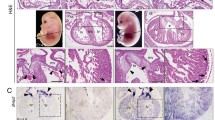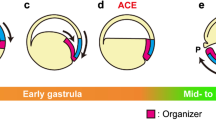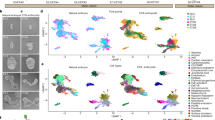Abstract
To elucidate the mechanisms of early heart morphogenesis in Xenopus laevis, we examined the effect of endoderm on heart morphogenesis in the early Xenopus neurula. Explants of anterior ventral (presumptive heart) mesoderm from early neurula were cultured alone or in combination with endoderm dissected from various regions. Heart formation was scored by an original heart index based on morphology. These explant studies revealed that anterior ventral endoderm plays a critical role in heart morphogenesis. Furthermore, we found that it was possible to confer this heart-forming ability on posterior ventral endoderm by the injection of poly(A)+ RNA from stage 13 anterior endoderm. These results imply that the heart formative factor(s) is localized in the anterior endoderm of the early neurula and that at least part of this activity is encoded by mRNA(s).
Similar content being viewed by others
References
Balinsky BI (1981) An introduction to embryology, 5th edn. Holt-Saunders International, Philadelphia
Dale L, Slack JMW (1987) Fate map for the 32-cell stage of Xenopus laevis. Development 99:527–551
Hardin J, Keller R (1988) The behaviour and function of bottle cells during gastrulation of Xenopus laevis. Development 103: 211–230
Ignotz RA, Endo T, Massagué J (1987) Regulation of fibronectin and type I collagen mRNA levels by transforming growth factor-β. J Biol Chem 262:6443–6446
Jacobson AG (1960) Influences of ectoderm and endoderm on heart differentiation in the newt. Dev Biol 2:138–154
Jacobson AG (1967) Amphibian cell culture, organ culture, and tissue dissociation. In: Wilt FH, Wessells NK (eds) Methods in developmental biology. Crowell, New York, pp 531–542
Jacobson AG, Sater AK (1988) Features of embryonic induction. Development 104:341–359
Keller RE (1976) Vital dye mapping of the gastrula and neurula of Xenopus laevis. II. Prospective areas and morphogenetic movements of the deep layer. Dev Biol 51:118–137
Kokan-Moore NP, Bolender DL, Lough J (1991) Secretion of inhibin βA by endoderm cultured from early embryonic chicken. Dev Biol 146:242–245
Linask KK, Lash JW (1986) Precardiac cell migration: fibronectin localization at mesoderm-endoderm interface during directional movement. Dev Biol 114:87–101
Linask KK, Lash JW (1988a) A role for fibronectin in the migration of avian precardiac cells. I. Dose-dependent effects of fibronectin antibody. Dev Biol 129:315–323
Linask KK, Lash JW (1988b) A role for fibronectin in the migration of avian precardiac cells. II. Rotation of the heart-forming region during different stages and their effects. Dev Biol 129: 324–329
Logan M, Mohan T (1993) Induction of cardiac muscle differentiation in isolated animal pole explants of Xenopus laevis embryos. Development 118:865–875
Mangold O (1957) Zur Analyse der Induktionsleistung des Entoderms der Neurula von Urodelen (Herz, Kiemen, Geschlechtszellen, Mundöffnung). Naturwissenschaften 44:289–290
Muslin AJ, Williams LT (1991) Well-defined growth factors promote cardiac development in axolotl mesodermal explants. Development 112:1095–1101
Nascone N, Mercola M (1995) An inductive role for the endoderm in Xenopus cardiogenesis. Development 121:515–523
Nieuwkoop PD, Faber J (1967) Normal table of Xenopus laevis (Daudin). North-Holland, Amsterdam
Orts-Llorca F (1963) Influence of the endoderm on heart differentiation during the early stages of development of the chicken embryo. Wilhelm Rouxs Arch Entwickelungsmech Org 154: 533–551
Reynolds ES (1963) The use of lead citrate at high pH as an electron-opaque stain in electon microscopy. J Cell Biol 17:208–212
Sater AK, Jacobson AG (1989) The specification of heart mesoderm occurs during gastrulation in Xenopus laevis. Development 105:821–830
Satek AK, Jacobson AG (1990) The role of the dorsal lip in the induction of heart mesoderm in Xenopus laevis. Development 108:461–470
Smith SC Armstrong JB (1990) Heart induction in wild-type and cardiac mutant axolotls (Ambystoma mexicanum). J Exp Zool 254:48–54
Sugi Y, Lough J (1994) Anterior endoderm is a specific effector of terminal cardiac myocyte differentiation of cells from the embryonic heart forming region. Dev Dyn 200:155–162
Author information
Authors and Affiliations
Rights and permissions
About this article
Cite this article
Tonegawa, A., Moriya, M., Tada, M. et al. Heart formative factor(s) is localized in the anterior endoderm of early Xenopus neurula. Roux's Arch Dev Biol 205, 282–289 (1996). https://doi.org/10.1007/BF00365806
Received:
Accepted:
Issue Date:
DOI: https://doi.org/10.1007/BF00365806




